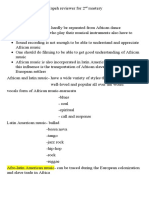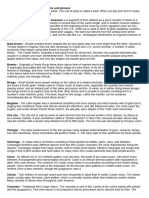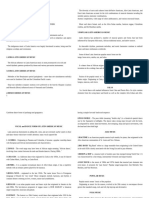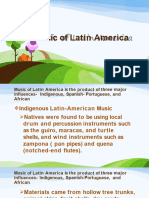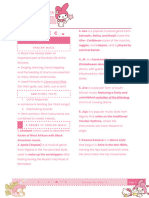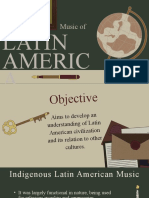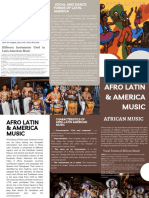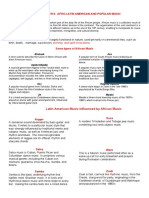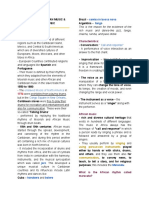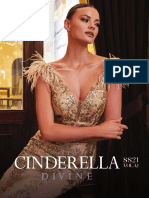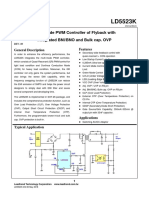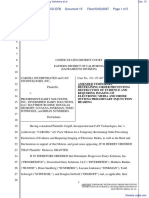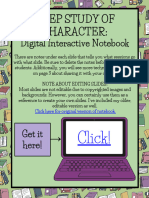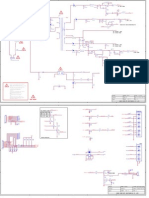0 ratings0% found this document useful (0 votes)
300 viewsReviewer 2nd Grading
Reviewer 2nd Grading
Uploaded by
Mariel Dela CruzLatin American music comprises styles that emerged from indigenous, European, and African influences. Some key musical forms include samba, son, and salsa, which incorporate elements of dance, percussion, vocals, and instrumentation. Rhythmic elements like syncopation, call-and-response, and complex polyrhythms are characteristic of many Latin American genres. Specific genres discussed include cumbia, tango, cha-cha, rumba, bossa nova, reggae, foxtrot, and paso doble.
Copyright:
© All Rights Reserved
Available Formats
Download as DOCX, PDF, TXT or read online from Scribd
Reviewer 2nd Grading
Reviewer 2nd Grading
Uploaded by
Mariel Dela Cruz0 ratings0% found this document useful (0 votes)
300 views11 pagesLatin American music comprises styles that emerged from indigenous, European, and African influences. Some key musical forms include samba, son, and salsa, which incorporate elements of dance, percussion, vocals, and instrumentation. Rhythmic elements like syncopation, call-and-response, and complex polyrhythms are characteristic of many Latin American genres. Specific genres discussed include cumbia, tango, cha-cha, rumba, bossa nova, reggae, foxtrot, and paso doble.
Original Title
Reviewer-2nd-grading.docx
Copyright
© © All Rights Reserved
Available Formats
DOCX, PDF, TXT or read online from Scribd
Share this document
Did you find this document useful?
Is this content inappropriate?
Latin American music comprises styles that emerged from indigenous, European, and African influences. Some key musical forms include samba, son, and salsa, which incorporate elements of dance, percussion, vocals, and instrumentation. Rhythmic elements like syncopation, call-and-response, and complex polyrhythms are characteristic of many Latin American genres. Specific genres discussed include cumbia, tango, cha-cha, rumba, bossa nova, reggae, foxtrot, and paso doble.
Copyright:
© All Rights Reserved
Available Formats
Download as DOCX, PDF, TXT or read online from Scribd
Download as docx, pdf, or txt
0 ratings0% found this document useful (0 votes)
300 views11 pagesReviewer 2nd Grading
Reviewer 2nd Grading
Uploaded by
Mariel Dela CruzLatin American music comprises styles that emerged from indigenous, European, and African influences. Some key musical forms include samba, son, and salsa, which incorporate elements of dance, percussion, vocals, and instrumentation. Rhythmic elements like syncopation, call-and-response, and complex polyrhythms are characteristic of many Latin American genres. Specific genres discussed include cumbia, tango, cha-cha, rumba, bossa nova, reggae, foxtrot, and paso doble.
Copyright:
© All Rights Reserved
Available Formats
Download as DOCX, PDF, TXT or read online from Scribd
Download as docx, pdf, or txt
You are on page 1of 11
MUSIC 5.
Spanish Decima - Decima is a song form that
Latin-American Music consists of 10 lines, each
- comprises several musical styles and genres having eight syllables.
that have emerged over time. Musical Forms of Latin-American Music
- incorporates African Music brought by 1. Samba
slaves who were transported to the - a dance form of African origin which later
Americas by European settlers. evolved into an African-Brazilian invention
Three Major Influences: among the working class and slum districts of
Indigenous Rio de Janeiro
European - Batucada is the most adventurous kind of
African samba.
Historical Background: - Samba music is in 2/4 time with a high bass
Indigenous Latin-American Music drum beat on the first beat, a lower
- was largely functional in nature. foundation beat on the second beat, and
- used for religious worship and ceremonies. highly syncoppated rhythms played over the
- African natives were found to be using local top.
drums, some percussion instruments, and - A bateria is a percussion band or rhythm
some wind instruments like the panpipes. section that plays the rhythmical part, while
- The materials were made from trees, animal melody instruments and singers play the tune.
skins, fruit shells, and other materials around - Samba can be performed by a single guitarist
them. or a mob.
Afro-Latin American Music 2. Son
- African influence on Latin-American Music is - a fusion of the popular music or Canciones of
largely felt in its varied and rich rhythmic Spain and the African rumba rhythms of Batu
patterns as performed by the drums and other origins.
percussion instruments. - It had its origin from Cuba.
Euro-Latin American Music - it is usually played on three guitars,
- Southern Chile and the Colombian Pacific used contrabass, bongos, maracas, and claves.
Renaissance melodies while Hispanic- and 3. Salsa
Moorish- influenced areas like Valenzuela and - a social dance of Cuban and Puerto Rican
Colombia used step-wise melodies. influence.
Characteristics of Latin-American Music - it contains the elements of the swing and
1. Language - Uses Spanish and Portugese hustle plus the complex.
language and sometimes the - Afro-Cuban and Afro-Caribbean dance forms
Creole. of pachanga and guaganco.
- can be characterized by its “extravagant and
2. Rhythm - Distinct and usually repetitive bass
rhythms clave-driven music anchored by piano, horns,
3. Syncopation - This is a musical style where and rhythm section, which is sung by a velvety-
weak rhythmic beats are voiced crooner in a sharkskin suit.”
accented instead of strong - its basic structure is based on the Cuban son,
ones. beginning with a simple melody and followed
4. Call and Response - This musical style has by a coro section in which the performers
two or more musical parts that go back improvise.
and forth in response to each other. 4. Vocal and dance forms
These can either be rhythmic beats or a. Cumbia
song lyrics. - was born of a cultural mix of black and
indigenous backgrounds.
- the origin of cumbia music started from the
days of slavery in the late 17th century and is d. Rumba
derived from the African word cumbe, which - is a family of percussive rhythms, songs, and
means last dance. dance.
- Cumbia originated in Panama - the name rumba was originally another way to
- It is one of the most melodic representative say party, and rumba music can certainly be
expressions of Colombia. thought of as energetic party music.
- It brings together three cultures - it is a recreational dance of Afro-Cuban origin,
African – rhythm normally uused as a ballroom dance.
Indigenous – flute instrument - is written with four beats to each measure, in
European – melodies, choreography, 4/4 time.
and costumes - One full step is completed in two measures of
- it is a traditional courtship dance characterized music.
by the persistent beat of a hand drum on the - Rumba rhythms, while once influenced by
upbeats of a two-four time and the African-style music, have found their way into
accompaniment of a shaker or scrapper and Country Western, Blues, Rock, and other
large gaita flutes. popular music types.
b. Tango - the music is sometimes enhanced by
- the word tango is said to have two origins: homemade instruments from the kitchen such
African – African dance as pots, pans, and spoons.
Spanish – taner means to play an e. Bossa Nova
Instrument - bossa nova means new trend in Portuguese or
- Tango came from a mixture of cultural something ccharming.
influences inclluding Africa, India, France, - it refers to a style of music popularized in
Spain, and Latin America. Brazil in the classic Cuban samba.
- Two distinct flavors of tango: - it uses elements of samba and jazz.
Melodic Argentinian Style - it combines melody, harmony, and rhythm
- Bandoneon, which is often accompanied by a into a swaying feeling.
small band, including a piano, guitar, one or - vocals are usually nasal.
two violins, and sometimes a singer. - bossa nova is cool and has a relaxed style.
- True Argentine tango music never has a heavy - the rhythmic base is taken from the intense
drum beat. and highly percussive samba and tends to be
Rhythmical European Style light and frothy, often featuring guitar and
- In contrast, is a strong march with a steady vocals, and brushes instead of sticks on the
consistent downbeat played by a snare drum. drum set.
- The music is often played by a large orchestra f. Reggae
with or without the bandoneon. - started in Jamaica, but has its roots in New
c. Cha-Cha Orleans R&B.
- was a breakaway from the usual accent of the - its forefather is the ska (a musical genre of an
fourth eight note or mambo. up tempo, rhythmic variation)
- its melody is sensual and involves commplex - the word reggae was coined around 1960 to
polyrhythms. identify a ragged style of dance music.
-was first popularized i the 1940s by Cuban - it uses lament-like style of chanting and
charanga bands which are comprised of piano, emphasizes the syncopated beat.
bass, violins, flute, and percussions (including - it is played in 4/4 time and emphasizes the
the timbales, a miniature version of the syncopated beat
orchestral timpani drums) - the tempo of reggae is usually slower and uses
simple chord progression.
- reggae must basically inverted the role of bass attached to each other.
and guitar. - the larger drum is called hembra (spanish for
- Robert Nesta Bob Marley became famous in female) and the smaller drum is called the
this musical genre. macho (spanish for male).
g. Foxtrot - bongos are traditionally held between the
- is typically danced to big band swing style legs, with the macho up against one thigh and
music written in 4/4 time. the hembra down against the opposite calf.
- the music tempo is 120 to 136 beats per 5. Conga Drum - also known as tumbadora, this
minute. is a tall, narrow, single-headed
- foxtrot music is often suitable for swing drum from Cuba.
dancing as well as for foxtrot dancing. - it is played by slapping down
- it gave rise to other dances like the Charleston, on the drum in the center with
black bottom, and shimmy. your palm, or tapping the
h. Paso Doble outside edges with your
- its origin dates back to a French military march fingertips.
entitled “Paso Doble” it means two steps in 6. Claves - this is a percussion instrument
Spanish. (idiophone), consisting of a pair of
- it is based on the music played at bullfights short thick dowels.
during the bullfighters’ entrance (paseo) or - traditionally, they are made of wood,
during the passes (faena) just before the kill. typically of rosewoo, ebony, or
- this was a fast-paced march, which is why this granadilla, one of which is held in the
is a fast-paced arrogant and dignified Latin player’s fingertips over the cupped
American music. hand (a resonator)
- Paso Doble music has strong Flamennco - when struck together they produce a
influences. sharp ringing sound.
- the tempo is usually a brisk 60-beat per 7. Cowbell - this is made out of hard metal and
minute. used to play strong rhythms.
- the spanish gypsy dance has become the - it is held securely in the palm of the
universal anthem of the Paso Doble. left hand and struck hard with a
Latin-American Instruments short metal stick.
1. Zampona – this is a series of hollow pipes Jazz Music and Other Forms
made from hollow reeds. Historical Background
2. Guiro – this is a percussion instrument - though jazz and classic blues are early 20th
consisting of an open-ended, hollow century black music innovation certain
gourd with parallel notches cut in one characteristics of jazz have their roots in much
side. earlier musical traditions.
- it is played by rubbing a stick or tines - Jazz music sprang from post-slavery African
along the notches to produce a American culture, as the children of slaves
ratchet sound. settled in big cities in the late 19th century.
3. Maracas – also called Rumba shakers, these - there, they began to fuse their musical
are rattles which are considered heritage with the influences of their new
unturned percussion instruments. surroundings.
- Players hold them by their handles, - no one has ever found the original source of
usually in pairs, and shake them. the word jazz, but it was used a s a non
4. Bongo Drums - this is a type of world musical slang term in America prior to being
percussion instrument used to describe the style of music.
traditionally made up of two -as a descendant and contemporary of blues,
different-sized drums
jazz began as a sort of folk music for black - Swing style (asymmetrical 8th notes)
Americans. - Accents on up beats.
- one of the earliest forms of jazz exists in the 2. Melody – Improvisation
form of ragtime, popularized by artists like - use of blue scale
Jelly Roll Morton who was self-credited as the - blue notes (lowered 5th degree
Inventor of Jazz and Scott Joplin. scale)
- New Orleans played a big role in the - uses bent notes (notes
development of jazz, when well-off Creole combinations that can be made on
musicians were forced into poorer Black piano)
communities and the two cultures’ music 3. Harmony – highly sophisticated
influenced each other. 4. Form – uniquely american
- jazz music shares much of the same 5. Dynamics – extreme
instrumentation. - experimenting on new sounds
- early jazz consisted of big brass bands which - emotional timbre
included trumpet, trombone, and saxophone. Jazz Music and Other Forms
- other instruments typical of jazz include the 1. Bebop – is a jazz style that featured complex
tuba, clarinet, upright bass, piano, and drums. melodies and chord progressions and
- as jazz developed in the 20th century, it was basically not adaptable to
became electrified, and the electric bass and dancing.
guitar became prominent jazz instruments. – it is more of art music than
- jazz’s adaptability has opened its doors to a entertainment.
variety of instruments, including bagpipes and - a vocal style known as scat also
steel pans. appeared.
- jazz became America’s most popular form of - nonsense syllables sung to an
music from the 1920s until the 1940s. improvised melody became the rage.
- big bands consited of groups of usually more - trumpeter Dizzy Gillespie is generally
than 12 performers playing arranged music considered to be the Father of Bebop.
intended for dancing. 2. Ragtime – is truly an African-American music.
- swing music, based on a shuffling kind of - rhythms brought form a musical
rhythm, became very popular, played by heritage in Africa were
famous band leaders like Count Basie, Duke incorporated into cakewalks, coon
Ellington, Glenn Miller, and Artie Shaw. songs, and the music of Jig Bands
- after a renewed interested in Dixieland music which eventually evolved into
in the 1940s, jazz music, as a popular ragtime.
commercial force, was eclipsed by rock and - the music was multi-themed, hard,
roll. bright, vibrant, enthusiastic, and
- it also served as a means of bringing young often extemporaneous.
people together. - soloists engaged in harmonic
- Louis armstrong was unquestionably the most improvisation, often avoided the
important single force in the development of melody altogether after the first
early jazz styles. chorus.
- there are many sub-genres of jazz, from the - usually the soloist was free to
early ragtime and swing to bebop, cool, and explore improvised possibilities as
west coast jazz and the later transmutations of long as they fit into the chord
acid, rock, free, and dub jazz styles. structure.
Characteristics of Jazz Music - often reffered to as the founding base
1. Rhythm – Strong but flexible syncopated of jazz styles, early ragtime music was
rhythms.
set forth in marches, waltzes, and other Digital Photographs – are printed, stored,
traditional song forms but the common manipulated, transmitted, displayed,
characteristics was syncopation (accents in and archived using digital computer
the melody is shifted away from the strong techniques, without any chemical
beats) processing.
- scott joplin is one of the most famous Cynthia Morris Sherman – one of the most
composers of ragtime music. respected American photographers of
3. Big Band – refers to a jazz group of ten or the late 20th century.
more musicians, usually featuring - majority of her photographs, although
at least three trumpets, two or featuring her self-pictures, are
more trombones, four or more definitely not her self-portraits.
saxophones, and a rhythm section - she used herself as a vehicle for
of accompanists playing some commentary on various issues of the
combination of piano, guitar, bass, modern world and in the process,
and drums. raised the important and challenging
- it was high-energy jazz style that question about the role of women in
packed the dance floors. the society, in the media, and their
- big band leaders at the height of nature in modern art.
this movement included Benny throughout her career, she has presented a
Goodman and Duke Ellington. sustained, eloquent, and provocative
4. Jazz Rock – this musical style is a hybrid exploration of the construction of
fusion of jazz and rock in the late contemporary indentity and the nature of
1960s and early 1970s when representation, drawn from the unlimited
musicians combined jazz harmony supply of images from movies, TV,
and improvisations with styles magazines, the internet, and art history.
such as funk, rock, rhythm and Processes Used to Create Digital Art
blues, and Latin jazz. 1. Computer Manipulation – this is the process
- also known as jazz fusion, this of altering, editing, or moving (text or
music often uses mixed meters, data) on a computer.
odd time signatures, syncopation, - it involves making changes to the
and complex chords and appearance of a photo for various
harmonies, and fusion includes a purposes such as advertisements,
number of electric instruments., magazines, book and music packaging,
such as electric guitar, electric bass, and gallery arrtwork.
electric piano, and synthesizer - photographs are modified to develop
keyboards. magazine covers, page layouts, and
- jazz vibraphonist Gary Burton may album or book covers.
be considered as an innovator of - multiple images are often combined to
this musical genre. create a juxtaposition, collage, or
ARTS unique image.
Digital Photography Photo Retouching – is a type of image
Digital Photography – uses electronic sensor of manipulation used in the modeling and
light or other electromagnetic acting industries where photos are
energy to capture an image retouched to correct or perfect shots,
which i stored and digitized to a with refinements, such as removing
computer for digital processing blemishes or moles, brightening eyes,
or digital printing. whitening teeth, and smoothing
wrinkles.
- common types of retouching include lighting paper, photo paper, canvas, glass, metal,
filters, contrast enhancement, brightness, marble, and other substances.
sharpness, and various other turning 5. Digital Circulation – this refers to the process
adjustments. involved in the circulation of digital
- professionals who manipulate images are content such as information, photos,
referred to as digital artists, graphic artists, and videos.
graphic designers, and photo editors. - various forms of media and technology
2. Light Setting – this process together with are being used in digital circulation.
proper camera positioning, are the keys to Digital Paintings and Imaging Videos-TV and
create perfect photographs. Film
- photographers who use digital cameras can Digital Painting – is an emerging art form
review their shots fter each take to see exactly wherein artists create art
how the light affects the whole photograph or objects digitally.
scene. - It also refers to a technique in
Tips in light Setting: making digital art using the
1. Use standard 3-point lighting set up computer.
2. Use light from left to right - digital painting differs from
3. Use background light with projection lens other forms of digital art,
and gobo ( a physical stencil or template that is particularly computer
placed inside or in front of a light source) to generated art, since it does
control the shape of the emitted light. not onvolve the computer
4. Use fill light with a mini soft box rendering from a model.
5. Use back light (against back wall) - Digital painters use painting
6. Use key light with soft box. techniques to create the digital
3. Digital ICE (Digital Image Correction and painting directly on the
Enhancement) – this refers to a set of computer, using a digitizing
technologies related to producing an altered tablet and stylus, and software.
image in a variety of frequency spectra with the - digital painting ptograms try to
objective of rendering a more usable image. mimic the use of physical media
- these technologies were most actively through style like oils, acrylics,
advanced in the 1960s and early 1970s in the pastels, charcoal, pen, and even
fields of strategic reconnaissance and medical media such as airbrushing.
electronics. - there are also certain effects
4. Digital Printing – this refers to printing unique to each type of digital
methods from a digital-based image directly to paint which portrays the
a variety of media using large-format and/or realistic effects of, for instance,
high-volume laser or inkjet printers. watercolor on a digital
- the greatest difference between digital “watercolor” painting.
printing and traditional method is that there is - in most digital painting
no need to replace printing plates in digital programs, the users can create
printing, resulting in quick turnaround time and their own brush style using a
lower costs, allowing for on-demand printing, combination of texture and
and even a modification of the image (vatiable shape.
data) used for each impression. - thrives mostly in production
- the most popular methods include inkjet or art and is most widely used in
laser printers that deposit pigment or toner conceptual design for film,
onto a wide variety of substrates including television, and video games.
- but while digital painting allows an artist the
ease of working in an organized, mess-free 7. Manhattan
environment, the artist will always be more in 8. Vistablet
control when he holds a physical brush in his 9. DigiPro
or her hand that gives a traditional painting a Graphic Tablets - have the funtcions of a
character that is unique in every physically mouse, and they are
made object. compatible with practically all
Digital Painting Softwares: Windows and Macintosh
1. Corel Painter software.
2. Adobe Photoshop Adobe Photoshop – was an early image
3. ArtRage manipulation program created
4. GIMP initially as a monochrome
5. Krita picture display program and
6. MyBrushes was eventually turned into an
7. openCnvas image editing program called
Various types of Digital Painting: Imagepre, and later changed to
1. Impressionism Photoshop.
2. Realism Adobe Illustrator – introduced the uses of
3. Watercolor Bezier curves which allows the
user to be incredibly detailed in
Characteristics of a Digital Painting: their vector drawings.
1. trannsparency Adobe Eazel – allows fingerpainting in
2. symmetry watercolor directly on the screen
3. distortion of an iPad, and export in a higher
4. repetition resolution to the larger working
5. embossed (creating 3d illusions) space of Photoshop CS5 on the
6. texture computer.
7. prefect circles, ellipses, squares and other Digital Video and Imaging
forms Video – is an electronic medium for the
8. flat surface recording, copying, playback,
Digital Painting Software broadcasting, and display of moving
Sketchpad – the earliest graphical manipulation visual media.
program created by Ivan - greatly vary in the resolution of the
Sutherland. display and refresh rate.
- it allowed the user to manipulate - they can be carried on a variety of
objects on a cathode ray tube media, including radio broadcast, tapes,
(CRT). DVDs, computer files, and so forth.
Intelligent Digitizer (ID) and Bitpad – used CAD - can be transmitted or transported on
(Computer Aided Programs) in a variety of ways-as an analog or
WACOM – leader in tablets and is available in digital signas in a wireless broadcast.
4x16 inches to 12x19 and less than Video Editing Processes – range from basic
an inch thick. operations like clipping and rearranging
Other Brands of Graphic Tablets scenes, and adding titles, transitions,
1. Aiptek and special effects, to more complex
2. Monoprice editing operations.
3. Hanvon PE
4. Genius Yoga - is a group of physical, mental, and
5. Adesso spiritual practices or disciplines which
6. Trust originated in Ancient India.
- It was developed between the fiifth and sixth
centuries and only gained prominence in the 2. Chair Pose
West in the 20th century.
- became popular as a system of physical
exercise across the Western world.
- in india, yoga is more than a physical exercise.
- it has a meditative and spiritual core.
- it connects our bodies and mind.
- yoga uses physical activity, breathing
techniques, and relaxation to help us connect
our bodies and minds.
- it is useful especially for people whose lifestyle
is hectic.
- many studies have tried to determine the
3. Crecent Moon Pose
effectiveness of yoga as a complementary
intervention for cancer, schizophrenia,
asthma, and heart disease,
- is also considered by some as meditative
means of discovering dysfunctional perception
and cognition as well as overcoming it for
release from suffering, inner peace, and
salvation.
- yoga poses are physical postures that exercise
one’s entire body, and stretch andd tone
muscles and joints.
Yoga Poses
1. Mountain Pose
4. Tree Pose
5. Child’s Pose 9. Rag Doll Pose
6. Downward Facing Dog Pose 10. Corpse Pose
7. Happy Baby Pose HEALTH
A. Philippine AIDS Prevention and Control Act
of 1998 (RA8504)
- promotes the prevention and control of
HIV/AIDS in the Philippines through the
promulgation of policies and implementation
of measures against the spread of HIV/AIDS
- it also aims to create a nationwide HIV/AIDS
information and educational program, form a
comprehensive HIV/AIDS monitoring system,
8. Butterfly Pose and make the Philippine AIDS cCouncil more
effective in its roles as the lead agency in
advisory, plannin, and policy-making for
HIV/AIDS prevention and control.
- this law covers the following policies
implemented by the state in order to prevent
and control the spread of Acquired Immune
Deficiency Syndrome (AIDS) which has
become one of the most life-threatening
diseases that has no known cure yet.
Promote public awareness about the
causes, modes of transmission,
consequences, means of prevention and
control of HIV/AIDS through a
comprehensive nationwide educational and
information campaign organized and
conducted by the state. Such campaigns
shall promote valu information and employ Lay down the legal principle that the
scientifically proven approaches, focus on provision of blood for transfusion is a
the family as basic social unit and be carried professional medical service and not a sale
out in all school and training centers, of a commodity.
workplaces, and communities. This program Provide for adequate, safe affordable, and
shall involve affected individuals and groups equitable distribution of supply of blood
including people living with HIV/AIDS. and blood products.
Extend every person suspected or known to Inform the public of the need for voluntary
be infected with HIV/AIDS full protection of blood donation to curb the hazards caused
his or her human rights and ciivil liberties. by commercial sale of blood.
Towards this end: Teach the benefits and rationale of
o Compulsary HIV testing shall be voluntary blood donation in the existing
considered unlawful unless otherwise health subjects of the formal education
provided in this act. system in all public and in privat schools, in
o The right to privacy of individuals with the elementary, high school, and college
HIV shall be guaranteed. levels as well as in the non-formal
o Discrimination in all its forms and educational system.
subtleties against individuals with HIV and Mobilize all sectors of the community to
persons perceived or suspected of having participate in mechanisms for voluntary and
HIV shall be considered inimical to non-profit collection of blood.
individual and national interest. Mandate the Department of Health to
o Provision of basic health and social establish and organize a National Blood
services for individuals with HIV shall be Transfusion Service Network in order to
assured. rationalize and improve the provision of
Promote utmost safety and universal adequate and safe supply of blood.
precautions in practices and procedures Provide for adequate assistance to
that carry the risk of HIV transmission. institutions promoting voluntary blood
Positively adddress and seek to eridicate donation and providing non-profit blood
conditions that aggravate the spread of HIV services, either through a system of
infection, including but not limited to reimbursement for costs from patients who
poverty, gender, inequality, prostitution, can afford to pay, or donations from
marginalization, drug abuse, and ignorance. governmental and non-governmental
Recognize the potential role of affected entities.
individuals in propagating vital information Require all blood collection units and blood
and educational messages about HIV/AIDS banks or centers to operate on a non-profit
and shall utilize their experience to warn basis.
the public about the disease. Establish scientific and professional
B. National Blood Services Act of 1994 standards for the operation of blood
(RA 7719) collection units and blood banks or centers
- revolves around the promotion of voluntary in the Philippines.
blood donation, the provision for an adequate Regulate and ensure the safety of all
supply of safe blood, the regulation of blood activities related to the collection, storage,
banks, and the provision of penalties for any and banking of blood.
violation of this law. Require upgrading of blood banks or
Promote and encourage voluntary blood centers to include preventive services and
donation by the citizenry and to instill education to control spread of blood
public consciousness of the principle that transfusion transmissible diseases.
blood donation is a humanitarian act.
C. Seat Belts Use Act of 1999 (RA 8750) Policies:
- aims to prevent vehicular accients and secure Guarantee the fundamental rights of
the safety of all the motorists of both private every child from all forms of neglect,
and public motor vehicles through mandatory cruelty, and other conditions prejudicial
enforcement of the use of seat belt devices. to his or her development.
- in particular, it requires the drivers and front Protect every child from all forms of
seat passengers to wear seat belt at all times exploitation and abuse including but
in order to avoid the ruinous andd extremely not limited to the following:
injurious effects of vehicular accidents. o The use of a child in
- the law also requires the vehicle pornographic performances
manufacturers to install seat belt devices in all and materials.
their manufactured vehicles. o The inducement of coercion of
a child to engage or be involved
A. Cybercrime Prevention Act of 2012 (RA in pornography through
10175) whatever means.
- prohibits all forms of cybercrime such as the Comply with international treaties to
misuse, abuse, and illegal access of which the Philippines is a signatory or a
information and data stored in the computer, state party concerning the right of
computer communications systems, networks, children which include but not limited
and databases. to the following:
- since such offenses are considered punishable, o The Convention on the Rights of
the law aims to prevent and combat them by the Child
facilitating an investigation and imposing o The Optional Protocal to the
penalties accordingly. Convention on the Pornography
- through this law, the integrity of computer, o The International Labor
computer communications systems, networks, Organization (ILO) Convention
and databases, and the confidentiality, No.182 on the Elimination of
integrity, and availability of information and the Worst Forms of Child Labor
data stored therein shall be protected. and the Convention Against
- this in turn would lead to a free, easy, and Transnational Organized Crime.
intelligible, access to exchange and/or delivery
of information, and would create an
environment conductive to the development,
advancement, rational application, and
effective use of information and
communications technology (ICT) both
domestically and internationally for fast and
reliable international cooperation.
B. Anti-Child Pornography Act of 2009 (RA
9775)
- condemns the crime of child pornography and
imposes penalties to such crimes.
- this law aims for the promotion of the youth’s
significant role in the nation’s overall
development as well as for the protection and
promotion of their physical, moral, spiritual,
intellectual, emotional, physchological, and
social well-being.
You might also like
- Colombian Rhythms on the Drumset: A Tour Accross Colombian RhythmsFrom EverandColombian Rhythms on the Drumset: A Tour Accross Colombian RhythmsRating: 5 out of 5 stars5/5 (1)
- Vocal and Dance Forms of Latin American MusicDocument21 pagesVocal and Dance Forms of Latin American MusicAlyssa Tammy Flores Ogoy100% (4)
- Exam Handbook - FinalDocument20 pagesExam Handbook - FinalAnonymous DbmKEDx67% (3)
- Mapeh ReviewerDocument14 pagesMapeh ReviewerDmitri OmahoyNo ratings yet
- Afro Latin Music BrochureDocument1 pageAfro Latin Music BrochureLimbo Kolokoy100% (1)
- Click Moko Report Ako Sa MapehDocument20 pagesClick Moko Report Ako Sa MapehFranco Evangelista 2No ratings yet
- Music ReviewerDocument8 pagesMusic ReviewerAliyah ElisiaNo ratings yet
- GRADE 10 Second Quarter Afro-Latin and Popular Music: 3. Maracatu CearenseDocument4 pagesGRADE 10 Second Quarter Afro-Latin and Popular Music: 3. Maracatu CearenseAndrei CometaNo ratings yet
- MusicDocument8 pagesMusicSophia Shannon D. DeiparineNo ratings yet
- Handouts - Music Grade 10 Q2 - Mam Praise PDFDocument2 pagesHandouts - Music Grade 10 Q2 - Mam Praise PDFLeny Jintalan BarisoNo ratings yet
- Some Common Latin Musical Terms and PhrasesDocument5 pagesSome Common Latin Musical Terms and PhrasesfilmwithvaiNo ratings yet
- Q2 MUSIC 10 - 2021-2022 Week 1Document68 pagesQ2 MUSIC 10 - 2021-2022 Week 1Rhoderick BantonNo ratings yet
- Mapeh Notes MikayDocument4 pagesMapeh Notes Mikaymugabe2405No ratings yet
- Lecture2 Music 10 q2Document4 pagesLecture2 Music 10 q2sqqjbb2vzhNo ratings yet
- Q2-MUSIC-10-AFRO-LATIN-AMERICAN-AND-POPULAR-MUSIC-NOTESDocument6 pagesQ2-MUSIC-10-AFRO-LATIN-AMERICAN-AND-POPULAR-MUSIC-NOTESsapphireaphrodite09No ratings yet
- Musiclasgr10 Q2W1Document58 pagesMusiclasgr10 Q2W1wieurie74No ratings yet
- MUSIC 2nd QuarterDocument61 pagesMUSIC 2nd QuarterregatonmagdalinoNo ratings yet
- Music of Latin AmericaDocument16 pagesMusic of Latin AmericaRonalyn Gatela CajudoNo ratings yet
- Afro-Latin American MusicDocument2 pagesAfro-Latin American MusicCHAPEL JUN PACIENTE50% (2)
- Mapeh Music Reviewer 3qaDocument3 pagesMapeh Music Reviewer 3qanelferfernandez11No ratings yet
- Mapeh Reviewer Ver. 2 - Quarter 2Document17 pagesMapeh Reviewer Ver. 2 - Quarter 2Arago, Sydny Ryz Cameron P.No ratings yet
- MAPEH 10 Q2 Lesson 2Document17 pagesMAPEH 10 Q2 Lesson 2H.N. BonjocNo ratings yet
- Mapeh Q2 Reviewer - All ComponentsDocument7 pagesMapeh Q2 Reviewer - All ComponentsmvrckjmnzNo ratings yet
- Music of Latin AmericaDocument8 pagesMusic of Latin AmericaTherese Guades PinoNo ratings yet
- Notes 2Document3 pagesNotes 2Krystalleah MaringuranNo ratings yet
- JHS - Q2 - MUSIC10 - 04 African and Latin American MusicDocument27 pagesJHS - Q2 - MUSIC10 - 04 African and Latin American MusicAaron Sibaot MunarNo ratings yet
- Lesson 2 Afro-Latin American MusicDocument22 pagesLesson 2 Afro-Latin American MusicRaylene San VicenteNo ratings yet
- Q1 Learning Module 2 Mapeh 10Document4 pagesQ1 Learning Module 2 Mapeh 10bilbao.aramaicaNo ratings yet
- African MusicDocument19 pagesAfrican MusicStephanie ChokeyNo ratings yet
- Music Second Grading Reviewer: History of Afro-Latin American MusicDocument6 pagesMusic Second Grading Reviewer: History of Afro-Latin American MusicGabrielle De CastroNo ratings yet
- Afro Latin American Music and Popular MusicDocument18 pagesAfro Latin American Music and Popular MusicMike JulianNo ratings yet
- Second MapehDocument20 pagesSecond MapehSkrt brrt brtNo ratings yet
- Music of Latin AmericaDocument15 pagesMusic of Latin AmericaLoryn Gail BañezNo ratings yet
- MusicDocument4 pagesMusicROSALIE SANCHEZNo ratings yet
- MusikaDocument3 pagesMusikaNicole ParkNo ratings yet
- African Music Characteristics of African Music in Terms of Rhythm, Melody, Harmony, Form and TextureDocument4 pagesAfrican Music Characteristics of African Music in Terms of Rhythm, Melody, Harmony, Form and TextureAsiya TucalNo ratings yet
- Inbound 1822068236479592889Document45 pagesInbound 1822068236479592889Gyver GaletesNo ratings yet
- Quarter 2 Music Afro Latin American and Popular Music HandoutDocument5 pagesQuarter 2 Music Afro Latin American and Popular Music HandoutJohn Gabriel SamaniegoNo ratings yet
- Lecture 2nd Quarter MAPEH 10 Final PDFDocument10 pagesLecture 2nd Quarter MAPEH 10 Final PDFhistoryadorNo ratings yet
- Lecture 2nd Quarter MAPEH 10 Final PDFDocument10 pagesLecture 2nd Quarter MAPEH 10 Final PDFshamera binayonNo ratings yet
- Music BrochureDocument2 pagesMusic BrochureRai Sea RamosNo ratings yet
- Vocal and Dance Form of Latin AmericaDocument1 pageVocal and Dance Form of Latin AmericaMiguel Antonio AlquizaNo ratings yet
- Music of AfricaDocument10 pagesMusic of AfricaKeonna LantoNo ratings yet
- Pink Aesthetic Nature Project Presentation 20241008 182527 0000-1-1Document38 pagesPink Aesthetic Nature Project Presentation 20241008 182527 0000-1-1bantiquealdrinjayNo ratings yet
- Business Modern Minimalist Brown Trifold BrochureDocument2 pagesBusiness Modern Minimalist Brown Trifold BrochureAntonia GuiribaNo ratings yet
- Grade 10 Music Quarter 2Document45 pagesGrade 10 Music Quarter 2angel100% (1)
- 22 Q2 MusicDocument8 pages22 Q2 MusicCes Michaela CadividaNo ratings yet
- Latin American MusicDocument40 pagesLatin American Music0323-0514No ratings yet
- 2ndq Music LectureDocument2 pages2ndq Music LectureJhon Eric PedrochieNo ratings yet
- MUSIC-OF-AFRICADocument3 pagesMUSIC-OF-AFRICAhomerseth12No ratings yet
- Afro Latin American Music Popular MusicDocument4 pagesAfro Latin American Music Popular Musickassandra sardoncilloNo ratings yet
- Music of Latin AmericaDocument73 pagesMusic of Latin AmericaLawrence Ivan Dela CruzNo ratings yet
- Group WellnessDocument16 pagesGroup WellnessNathaniel TuralNo ratings yet
- Latin American Musical Styles-: Calypso-A Form of Music and DanceDocument14 pagesLatin American Musical Styles-: Calypso-A Form of Music and DanceJennifer ArnaizNo ratings yet
- REVIEWER%20MAPEHDocument11 pagesREVIEWER%20MAPEHKyla CampoNo ratings yet
- Music G10 2 Quarter Latin American Music: Mark Anthony P. Janer Teacher IDocument14 pagesMusic G10 2 Quarter Latin American Music: Mark Anthony P. Janer Teacher IAiza Rhea SantosNo ratings yet
- MAPEH 10 NOTES 2nd Quarter VMMPDocument14 pagesMAPEH 10 NOTES 2nd Quarter VMMPelgincolinvictor9No ratings yet
- Influences On Latin American MusicDocument3 pagesInfluences On Latin American MusicTherese Eva Marie DequitoNo ratings yet
- Afro Latin American and Popular Music LectureDocument20 pagesAfro Latin American and Popular Music Lecturedesiertonathan1608No ratings yet
- Afro-Latin America and Popular MusicDocument37 pagesAfro-Latin America and Popular MusicLai AnNo ratings yet
- Vocal Forms of American MusicDocument5 pagesVocal Forms of American MusicCharles ApelacioNo ratings yet
- Intr ExclDocument21 pagesIntr ExclNirupama ChowdaryNo ratings yet
- Taobao ReportDocument3 pagesTaobao ReportAmy Lin ChenNo ratings yet
- Jonathan Whiteley Auth. Finite Element Methods A Practical GuideDocument236 pagesJonathan Whiteley Auth. Finite Element Methods A Practical GuideBhupendra Sharma89% (9)
- Capsule - Camera: MVGR College of EngineeringDocument6 pagesCapsule - Camera: MVGR College of EngineeringkattasrinivasNo ratings yet
- Cinderella 2021 CatalogDocument172 pagesCinderella 2021 CatalogdigitalmagnoliaNo ratings yet
- Eztrieve Manual PDFDocument2 pagesEztrieve Manual PDFByronNo ratings yet
- Wipro Previous Year Question PaperDocument18 pagesWipro Previous Year Question PaperSrikanth SrikanthNo ratings yet
- JD - Trading Desk Analyst - Mumbai PDFDocument2 pagesJD - Trading Desk Analyst - Mumbai PDFsaireddy19No ratings yet
- Analog Inputoutput ModulesDocument330 pagesAnalog Inputoutput ModulesMaulana YasirNo ratings yet
- LD5523K DS 00Document17 pagesLD5523K DS 00Sumit SinghNo ratings yet
- SS ZG 552 Software Testing Methodologies: BITS PilaniDocument42 pagesSS ZG 552 Software Testing Methodologies: BITS PilaniTkt ToppoNo ratings yet
- 7&8 Food ProcessingDocument1 page7&8 Food ProcessingArgelyn PedernalNo ratings yet
- A Corner Stitching Compliant B-Tree RepresentationDocument5 pagesA Corner Stitching Compliant B-Tree Representationxzxuan2005No ratings yet
- International Roaming RatesDocument6 pagesInternational Roaming RatesHannes MaraisNo ratings yet
- Cargill Incorporated Et Al v. Progressive Dairy Solutions Et Al - Document No. 15Document5 pagesCargill Incorporated Et Al v. Progressive Dairy Solutions Et Al - Document No. 15Justia.comNo ratings yet
- Resume Rhiannonzionzee GameprogrammerDocument2 pagesResume Rhiannonzionzee Gameprogrammerapi-437898718No ratings yet
- Warmer Girrafe and PandaDocument208 pagesWarmer Girrafe and Pandagamal elhanafeyNo ratings yet
- The Walkthrough Method:an Approach To The Study OfappsDocument27 pagesThe Walkthrough Method:an Approach To The Study Ofappstan nguyenNo ratings yet
- Minor Project End Term ReportDocument27 pagesMinor Project End Term ReportMohd Mujtaba AkhtarNo ratings yet
- Container Service PDFDocument84 pagesContainer Service PDFjunk emailNo ratings yet
- Big Data in The Public Sector Selected Applications and Lessons Learned PDFDocument64 pagesBig Data in The Public Sector Selected Applications and Lessons Learned PDFharaNo ratings yet
- Tfestimate: SyntaxDocument14 pagesTfestimate: Syntaxsafinasal7432No ratings yet
- Spam ListDocument11 pagesSpam ListSaravanaKumar ArumugamNo ratings yet
- Digital Interactive Notebook: Deep Study of CharacterDocument12 pagesDigital Interactive Notebook: Deep Study of Characterkaren.nadeauNo ratings yet
- Nor Nand Flash GuideDocument9 pagesNor Nand Flash GuidejvgediyaNo ratings yet
- Marcas Varias DVD Con Procesador Zoran Manual de ServicioDocument44 pagesMarcas Varias DVD Con Procesador Zoran Manual de ServicioVicente MalvicaNo ratings yet
- Scorpion B-Scan Manual Rev 6.0 PDFDocument63 pagesScorpion B-Scan Manual Rev 6.0 PDFAsish desaiNo ratings yet
- Android-Based Home Automation Using Bluetooth and ESP8266Document10 pagesAndroid-Based Home Automation Using Bluetooth and ESP8266robert.cesarNo ratings yet
- Bloom's Taxonomy For CS Assessment: Errol Thompson Andrew Luxton-Reilly Jacqueline L. WhalleyDocument8 pagesBloom's Taxonomy For CS Assessment: Errol Thompson Andrew Luxton-Reilly Jacqueline L. Whalleymariana henteaNo ratings yet



